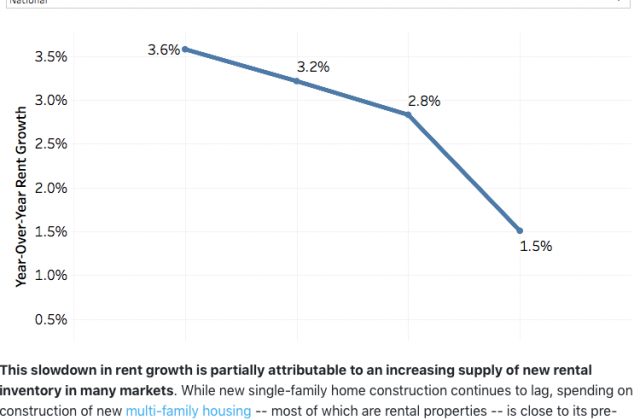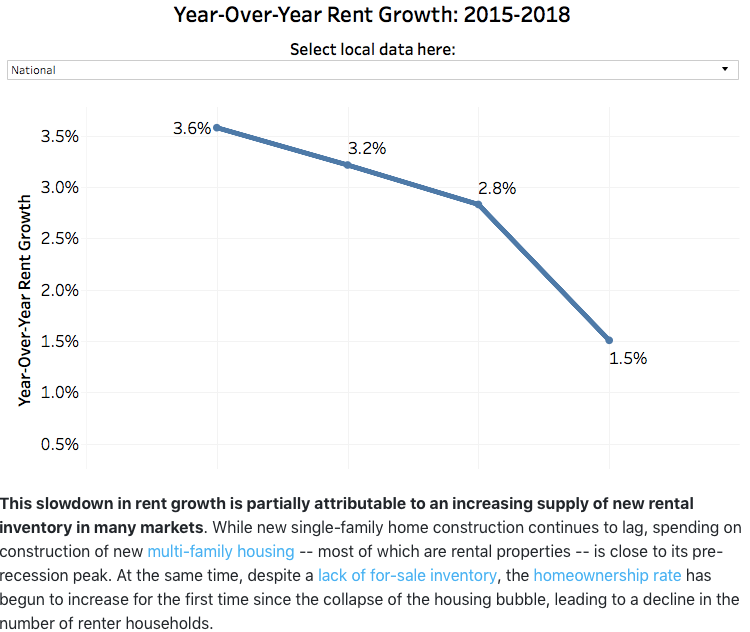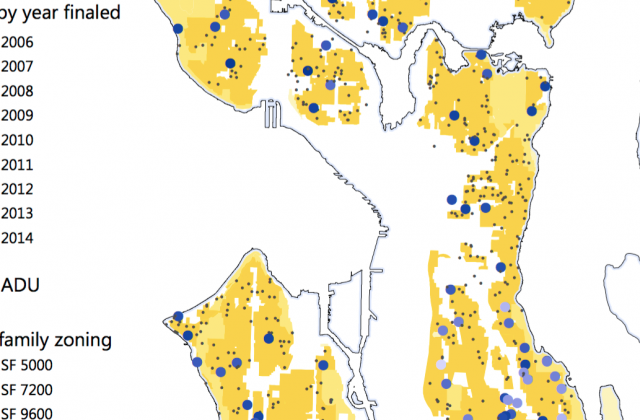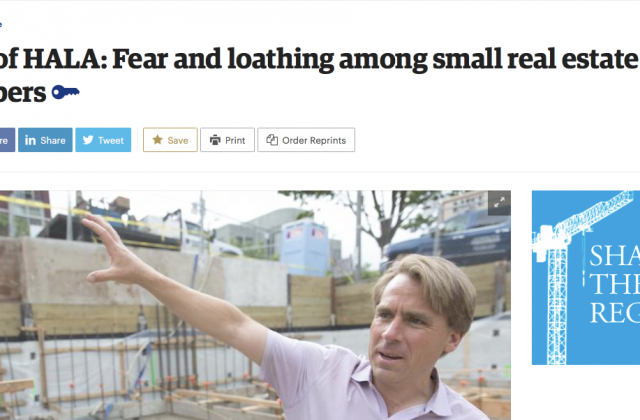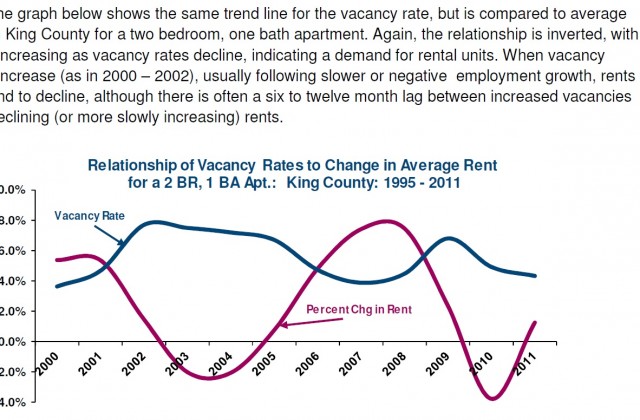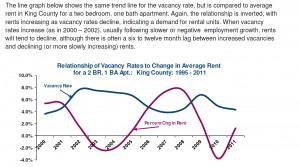Where Are Rents Rising Fast? Not Seattle.
I’m not going to write much, just link to a recent study of rents nationwide by Apartment List, a paragraph and two images.
Here’s the paragraph:
City rankings change substantially from year to year. From 2017 to 2018, Seattle experienced the largest drop in the rankings, after experiencing rent growth above 5 percent for each year from 2015 to 2017. In fact, in 2017, Seattle had the fastest rent growth of the nation’s 25 largest cities at 5.2 percent. In the year ending June 1, 2018, however, Seattle saw its rank fall to #22, with rents decreasing by 0.9 percent. Seattle has seen a record number of new units hit the market over the past couple of years, and it seems that all this new supply has now put a halt to the city’s rent growth. Interestingly, while Seattle’s rent growth has dropped off, the city’s for-sale inventory is still tightly constrained, and the city’s home prices are the fastest-growing in the nation. Similar slowdowns can be seen in Portland and Denver, both of which have also added substantial amounts of new rental housing.
And this picture:
And this picture:
Maybe I’ll write more later but right now, as they say, I’m just shaking my head.
Council Flips and Flops: Repeal of Tax on Jobs Set for Noon Today
What’s a more stunning indictment of an elected body, making horrible policy on weak principles or, when confronted with an angry public after doing that, doing a 180 and repealing the policy? The Seattle City Council will have done both when later today by most reports they will repeal the tax on jobs they passed only a month ago. Taxing jobs makes no sense. Jobs are good and by every measure have a net benefit on the economy by creating more income opportunities for people. I’ve been over most of the arguments, including the fact that the proposed tax wouldn’t buy much anyway; we’d be better off using it to help people pay their rent.
There is lots of speculation of course about what this sudden change means. It will take a while for that to become clear. But one thing for sure, it shows how utterly incoherent the City Council has become as a decision making body. Remember all those passionate speeches about how the Council needed to stand up to big business to “solve” the problem of homelessness?
When Amazon said they were pausing expansion plans in Seattle Councilmembers took offense, with Councilmember Lorena Gonzalez saying,
Greater shared responsibility equals greater shared prosperity for all, businesses and residents alike.
Now she says,
I am deeply troubled and disappointed by the political tactics utilized by a powerful faction of corporations that seem to prioritize corporations over people. The consequences of delaying action will be felt most profoundly by the thousands of people currently suffering while seeking stable housing and emergency shelter in our City.
Yet Gonzalez will vote to repeal the tax she said was about sharing responsibility.
If anyone was wondering why it’s time for the Council to be replaced this is the best evidence of why; they can’t make deals or decisions and are simply blown about by whatever the see right in front of them at the moment. The tax on jobs is a bad idea. It should be repealed. But why was it ever passed and signed into law in the first place. What is true about the tax on jobs is true about Mandatory Inclusionary Zoning (MIZ); bad policy passed for the wrong reasons (to punish a business sector), with downsides (like pushing up the costs of all housing), and very little benefit (not much subsidized housing for the trouble).
It’s Not the Code but Lack of Financing the Prevents DADUs
The latest big social media buzz in and around City Hall is the fight between some angry neighbors and the City over the last round of regulations on Detached Accessory Dwelling Units or DADUs and also called back yard cottages. The recent regulation was appealed by the neighbors and was bogged down in an additional required environmental analysis on the impacts. If you read the headlines, some of the breathless, and scanned the articles and posts you might come away believing that this legislation would determine whether or not DADUs would be allowed. But here’s the thing, DADUs are already allowed by the code and this legislation won’t do anything to make them more prevalent as rental housing. The reason is the lack of a market for DADUs and an absence of financing because of the limits in the existing code.
If you want the arcane details of the latest feud you can look at Sightline’s recent letter on the City’s Environmental Impact Statement (EIS). I have been writing about cottages and DADUs for more than a decade, and it was about ten years ago when the City finally permitted detached dwelling units; previously they had only been allowed as attached to the main house. Then in 2006, the City allowed 50 units to be built just in the southeast sector of the city. Then they subsequently allowed them everywhere. Over the period of time since then, about 159 units have been built or permitted all over the city, or roughly a dozen a year. Yes, a dozen.
Is that modest production the result of onerous regulation? The regulation doesn’t help. But the bigger problem is the absence of money to pay for cottages and the irregular nature of lots that might be eligible. I worked with an internet start up to figure out how many eligible lots there might be under the existing code, and we found hundreds. Are all those households jumping up and down wanting to build rental housing in their backyard. Not really. Not every single-family lot owner that could fit a DADU in their back yard wants to, and often, we found, their motivations aren’t rental housing but providing a place for a family member who is rolling out of a sale of their existing house; grandma and grandpa sold their house in Peoria and want to live in Seattle next to the kids and grandkids.
How do you pay for a backyard cottage? The answer is typically from the sale of grandma and grandpa’s home. But that doesn’t lead to a rental unit. The other is a home equity loan, essentially a second mortgage on the existing home and land with those assets as collateral. The going price for a cottage is around $150,000 or so. But that can vary. And equity varies as well. Not everyone who is paying a mortgage or even owns their home can or wants to take out yet another loan. Also, each and every single-family site is different. Some don’t have alley access and some have other issues with utilities. So all those hundreds of eligible lots winnows down to a very small number of people who are willing to take on a project. Architects and builders don’t like to do one off projects. They’re expensive, hard to manage, and take up a lot of time.
So today, there just isn’t a market for DADU construction for rental housing. There isn’t a lot of demand for building it and builders and architects don’t really have a product or service ready to go if there was a surge in demand. What’s the answer? Exactly what the neighbors and the City don’t want, professionals coming in and building lots of DADUs.
First, anyway you slice the money, the biggest incentive for motivating DADU construction would be financing that would be based on rent revenue from the cottage. Banks simply don’t lend money this way for a cottage. They need collateral in the form of the existing house which often already has a mortgage. Additionally, for regulatory reasons, mortgages have to be for a house, not a rental property. There simply isn’t a product that would lend money to a homeowner based on the rent that would be collected. Lots of people hand wave this, but to really accelerate people making the jump from homeowner to landlord would require dividing the lot to allow the cottage to be financed separately, just like a speculative housing unit. Banks know how to lend for that.
If this happened, the cottage could pay for itself with rent revenue. If something went wrong, the bank would have the cottage as collateral and could sell the home to get it’s money back. The homeowner wouldn’t lose their existing home. This kind of financing could generate a market for design and architectural services to create stock designs and a scale for builders that could turn out lots of cottages. Builders and entrepreneurs could pitch homeowners with a lot to buy a service with loan, design, construction, and property management all together for one price paid for by rents from the cottage. This could catch on and create many more rental units.
But we’ve been here before. Remember the small-lot housing battles of 2013 and 2014? Probably not. We lost. Essentially the City Council outlawed building single-family housing on lots smaller than standard 5000 square foot lots. The reason? Too many people, parking, and yes, greedy developers and others making money. The DADU challenge is the same. Unless there is a motive to make a return on investment of time and money by architects, builders, and others in real estate there simply isn’t scale to sustain a business model that produces cottages. And homeowners are unlikely to take a big financial risk unless there is easy and less risky financing to buy those services. And the financing won’t happen unless there is a return on the banks investment.
This is why markets are good things. Tweaking the existing rules on DADUs simply doesn’t matter and won’t create a waterfall of new rental housing in single-family neighborhoods. What would accomplish a big spike in DADU production is allowing property owners to divide their property, create a new asset that can support a loan and thus the money to buy the professional services at a scale that makes business sense. And yes, the details of the code (i.e. setbacks, height, etc) limits a lot of potential too, but fixing those won’t spark new rental housing. Homeowners, the Council, and neighbors need to see the business opportunity in their backyard. Until that happens, DADUs will remain a largely theoretical land use debate with little benefit to people who need housing.
Fear, Loathing, and Confusion Persist About Mandatory Inclusionary Zoning
Last week the Puget Sound Business Journal ran a story called “Ahead of HALA: Fear and loathing among small real estate developers.” The story is locked behind a pay wall, but here’s a key paragraph:
HALA is built on the idea that even with the added fees, the MHA program is worth it since developers get to build projects with more rent-producing space. But building bigger, taller buildings is more complicated and more expensive. Plus, “the city isn’t a very reliable partner,” Neiman said.
It’s annoying that throughout the story, the Housing Affordability and Livability Agenda (HALA) Committee report is confounded with the City’s version of Mandatory Inclusionary Zoning (MIZ) called Mandatory Housing Affordability (MHA). It’s simply shocking that after three years, this distinction is still not being made in the media.
But I’ll take the story. It’s the first time I can remember where a local journalist has actually talked with people who design and build housing about how MHA won’t work to solve any problems only add costs and make housing more difficult to build. I spoke with the PSBJ for the story but wasn’t quoted. Which is fine. I’ve been repeating over and over again that MHA will make many projects infeasible, is inflationary, boosting prices and rents to cover fees, and finally illegal.
I’ve also made these points about a million times:
In downtown and South Lake Union, though, there’s been little pushback and developers have embraced the program.
Developers in the urban core “got a really sweet deal,” said Neiman, because they were at the table when the HALA deal was struck.
“No one was there to negotiate a fair deal for small developers out in the neighborhoods,” he said.
Now, with MHA fees, “It is very difficult to get any projects to pencil out,” said Armbruster, who thinks the current situation will slow down development only until the MHA takes shape.
“Given enough time, it will all balance out,” he said. “But I will guarantee you market rate housing will be more expensive.”
Do I think now the City will stop and consider the damage they will do to the housing economy if they push ahead? Probably not. It’s probably going to require legal action to make that happen.
Looking Back: Our Message Hasn’t Changed, Our Mission Is the Same
It is always important to remember what we are for, right? After all, this is part of our branding, “What are you for?” In January of 2014 I gave this kick off speech at the Community Development Roundtable, a group that was convened by the Greater Seattle Chamber of Commerce. Here it is just like I gave it back then. Our mission and vision is still the same, increase housing supply so that everyone who wants to live in Seattle can live here.
In Seattle, some people think that if housing prices go up, we ought to control those prices so they stay the same or go lower using land use regulation and rent control. Planners and City staff should decide prices based on a ratio of gross monthly income to housing cost; and the same planners and staff should determine how much return private investors should receive from successful projects.
This view ignores the fact that real people in the housing market don’t buy housing based on a percentage of their gross income, but on the consideration of the utility and disutility one housing choice over another, only one of which is the monthly price. Even for poor people, location, schools, and safety matter when choosing where to live. The dominant view about housing also ignores the truth that profit is the benefit of successfully taking a risk.
We also believe that the people who build housing and workspace— whether they are use a hammer or an Excel spreadsheet—are building Seattle’s future.
There is a different view in Seattle, however: if we want to affect housing price we need to increase supply to keep up with or exceed demand. If we were truly worried about the price of housing getting too high, then we would permit more housing, and many different kinds of housing, in every neighborhood in Seattle.
These two views about price have been around as long as there have been markets. When wages don’t seem to be going up fast enough and prices seem to high, some people are tempted to intervene, to force the issue. “Let’s set wages and prices so they are predictable; let’s make sure there are more winners than losers.”
Supply and Demand: Yes, it really works that way!
But we say, “let’s create more jobs and wages will go up; let’s create more housing and prices will go down.” And microhousing is the perfect example of a profitable venture that meets housing need for people who want or need to spend less money on housing.
In today’s housing market producers of housing are vexed by some neighbors who fear change, and some social progressives who want price controls, and a City Council unwilling to loosen their grip on how we use our land. Instead of loosening their grip on how we use land in Seattle, the Council’s tendency, in the face of rising demand, is to clench.
That’s why we created Smart Growth Seattle, to advocate for more innovative housing solutions. We believe that population growth should happen in our city, not in sprawling suburbs. Growth in the city is more sustainable, efficient, and economically beneficial.
- Housing Choice;
- Urban Density;
- Sustainable Development;
- Economic Opportunity; and
- Architectural Diversity
We want more jobs in Seattle and more housing for the workers who are seeking those jobs.
We believe that we should build more single-family homes, a wider variety of multifamily housing, and more workspace for employers all over our city.
Good things happen when we increase housing supply. When there are fewer homes to choose from and demand is high, prices tend to climb and buyers compete with buyers for scarce housing choices. When we allow more building, then there are more homes to choose from, and then landlords and developers have to compete with each other for buyers. More building also means more family wage jobs. We think the second option, building more, makes Seattle a better, more sustainable, and welcoming place to live.
We also believe that the people who build housing and workspace— whether they are use a hammer or an Excel spreadsheet—are building Seattle’s future. We intend to make their case and to argue that people of all incomes, classes, and origins who move to this city to live and work should find a warm embrace, not fear of change and high prices.
Join with me, and the partners of Smart Growth Seattle, in making 2014 the Year of Increased Housing Supply. Invite us back in a year and ask us about the progress we’ve made in shifting our civic discussion away from scarcity to abundance, from fear of change to having open arms for new people, and a local economy that can provide housing and shelter opportunity for everyone in our city.
